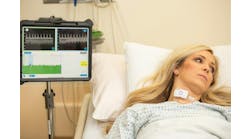The Centers for Medicare & Medicaid Services (CMS), hospitals, and insurers alike are striving to better define and measure quality of healthcare, of which patient satisfaction is a major component. Indeed, patient satisfaction is critical to how well patients do; research has identified a clear link between patient outcomes and patient satisfaction scores. Without a doubt, beyond providing the best clinical care possible for their patients, hospitals need to show their communities that they are interested in quality care.
To this end, a little more than a year ago, Genesis HealthCare System, an integrated healthcare delivery system in Zanesville, Ohio that includes a 603-bed general medical and surgical hospital and more than 2,700 employees, implemented a mobile rounding solution from the San Francisco-based Vocera as a pilot program to help boost patient and family engagement in the care plan. The solution measures and manages patient experience during a hospital stay in real-time to evaluate gaps and deploy improvement interventions.
Using Vocera Care Rounds, which runs on staff iPads, Genesis is able to gather real-time feedback and insights from patients and their families during the rounding process so that issues can be addressed during a patient’s hospital stay, says Abby Nguyen, chief nursing officer of Genesis HealthCare System. By approaching patients face-to-face, leaders at Genesis are able to capture compliments and complaints, and immediately request help from specific departments by typing into the app. Within a few months after implementing the software-based mobile solution, Genesis experienced a 35 percent increase in the hospital’s overall Hospital Consumer Assessment of Healthcare Providers and Systems (HCAHPS) rating, Nguyen says.
Nguyen says that prior to implementation of this system, Genesis didn’t have a formalized process, and as a result, the organization was always reacting rather than being proactive. “We weren’t seeking feedback, but were instead waiting for an issue to come up,” she says. Now, Genesis team members have the instant ability to respond to patient needs—anything from changing a light bulb to providing a special meal, adds Nguyen. “Through the Vocera application, we can submit a work order right there in the patient’s room and have someone come up and replace the light bulb or work on the TV, for example,” she says. One time, Nguyen continues, a patient made a comment that the nurse call button was too loud in the patient’s room. The patient understood why it needs to be loud outside, but not in his room, she explains. “So we have lowered the volume based on that feedback. It’s something that was very apparent and obvious, yet not something we had thought of before. Had that interaction not taken place, this improvement never would have happened,” Nguyen says.
Nguyen notes that it takes an organization-wide effort to conduct the “leader rounding” at Genesis, which includes a combination of managers, directors and senior executives from all areas—not just clinical—that are on a schedule and go through a rotation assigned to them. “They’re the ones who go around and interact with the patients,” Nguyen says. “Nursing is obviously one of the most integral groups that interacts with patients, but none of us would be here working if it weren’t for the patient. Everyone here touches the patient in some way, via the front end or the back end. Leaders across the organization have the opportunity and ability to interact with the patient and understand the patient experience better. I thought that was important, so we have leaders at all levels do the rounding,” Nguyen says.
What’s more, since implementing the solution, 90 percent of the patient feedback that Genesis has received is positive, including approximately 40 comments per week from patients about staff members, Nguyen notes. As such, the organization was not too surprised when it experienced the improved HCAHPS rating. “I think if you do the best thing for the patients, and meet their needs, the satisfaction scores will follow,” Nguyen says. “I don’t believe in, or like to implement, initiatives or projects for the outcome of increasing patient satisfaction scores. Our goal was truly to have a more structured, proactive way to hear what the patient and family was saying. With this, we are able to meet patients’ needs instead of hearing what we could have done better on a survey weeks after discharge,” she says, noting that one patient recently mentioned that no other organization she has been in has taken the time to ask about these types of things. “Patients know their voice is being heard when they see their feedback being addressed immediately, which helps create a healing environment, improve outcomes and build lasting loyalty,” Nguyen says.
Providers, too, have taken to the solution, Nguyen adds. Although many were a bit nervous at first, wondering what the result will look like, they are now appreciating it just as much as the patients. “It’s another set of eyes and ears for them, as they’re hearing all of the positive [feedback]. For the nursing staff especially, I think that maybe this has stepped up their game a little bit, because they know there will be a leader rounding every day that involves patient interactions,” Nguyen says. But the providers are just as excited, she adds. “This type of feedback is what makes their day.”


